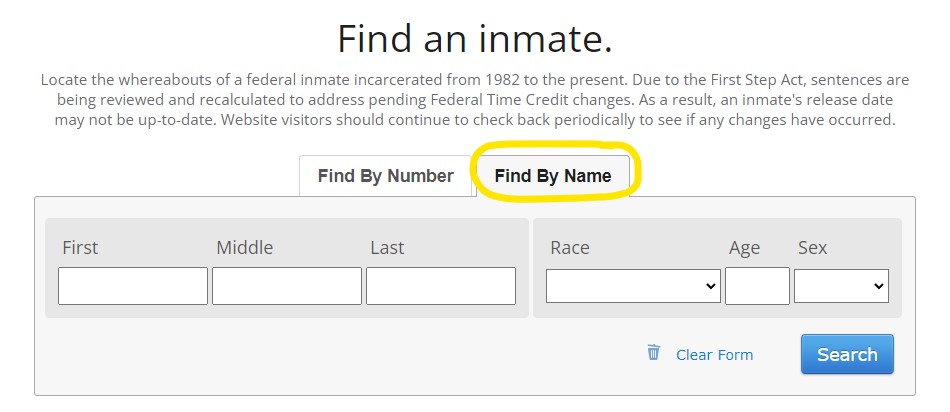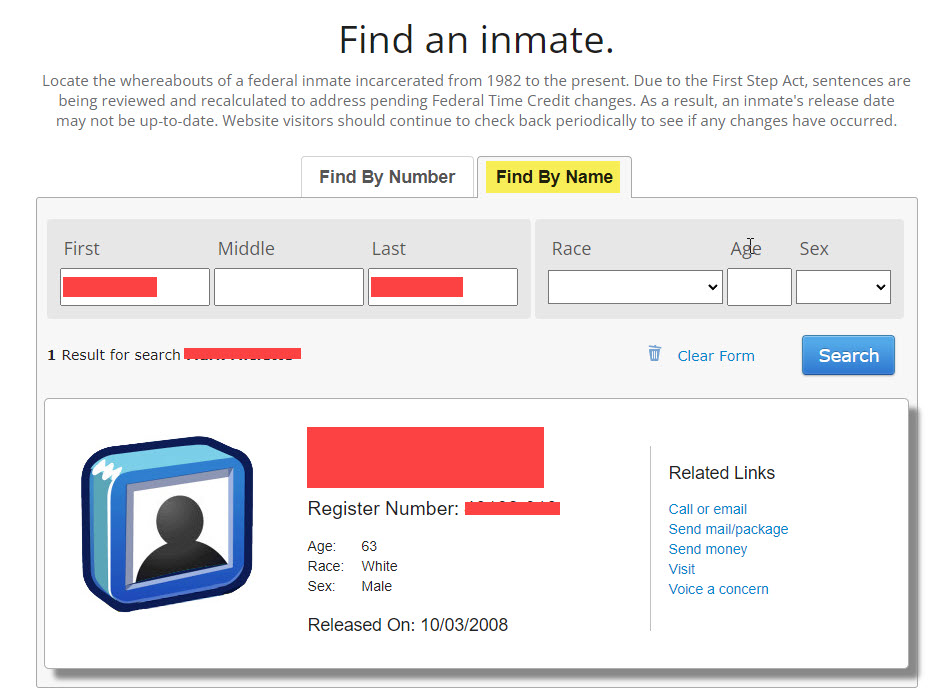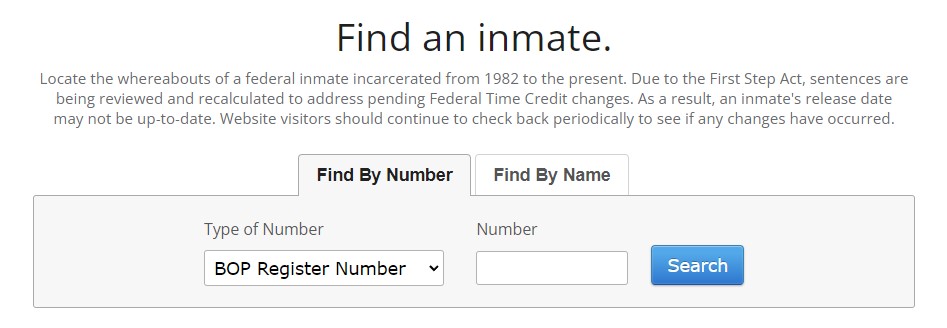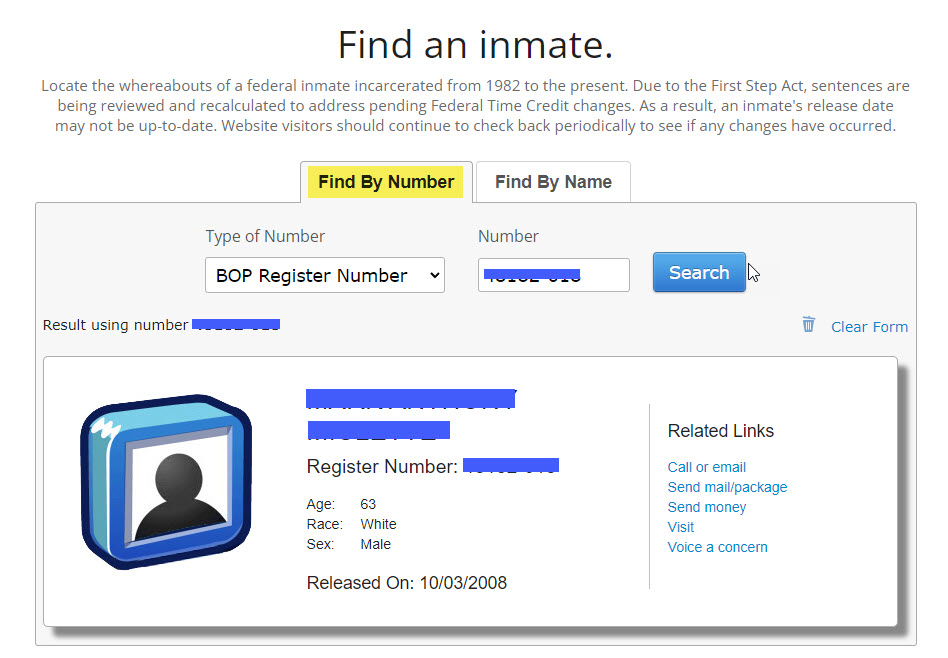
Phone: 812-244-4400
Physical Address:
USP Terre Haute
4200 Bureau Road South
Terre Haute, IN 47802
Mailing Address (personal mail):
Inmate's Full Name & Inmate Register Number
USP Terre Haute
Inmate Name and Registration Number
USP Terra Haute, U.S Penitentary
P.O. Box 33
Terre Haute, IN 47808
Other Jails and Prisons

The Bureau of Prisons Inmate Locator includes inmates that are not only in custody, but who have been in custody and have been released (or who died in custody) since 1982.
For inmates in custody prior to 1982, visit the National Archives Records Administration and provide the following information:
Searching by Name

Searching by Name Results

Searching by Number

Searching by Number Result

Things to Know About Federal Inmate Search Results
| Gender | Inmates | % Total |
|---|---|---|
| Male | 147,892 | 93.18% |
| Female | 10,819 | 6.82% |
| Total | 158,711 | 100.0% |
| Race | Inmates | % Total |
|---|---|---|
| White | 40,670 | 27.47% |
| Black | 56,938 | 38.46% |
| Hispanic | 44,515 | 30.07% |
| Other | 5,916 | 4.00% |
| Total | 148,039 | 100.0% |

There are three ways to deposit money in an inmate's account in the Federal Bureau of Prisons:
In order to do any of these you need to know the exact name the inmate is incarcerated under, and their Inmate ID# (aka Register Number)
If you can't find the inmate and Register Number online, use the online contact form to request help.
1. USP Terre Haute and Moneygram
You can send an inmate funds electronically using MoneyGram's ExpressPayment Program.
You can send money either online or at a Moneygram location.
- Funds are received and processed seven days per week, including holidays.
- Funds sent between 7:00AM - 9:00PM EST are posted within 2 to 4 hours.
- Funds sent after 9:00PM EST are posted at 7:00AM EST the following morning.
- If you have any questions you may contact BOP staff at 202-307-2712 between 8:00AM and 4:30PM EST.
NOTE: Do not send money until the inmate has actually arrived to the facility he has been assigned. At that point you can locate their location online.
Please visit https://www.moneygram.com/mgo/us/en/paybills, and enter the receive code 7932 or Federal Bureau of Prisons.
First time users will have to set up a profile and account.
A MasterCard or Visa credit card is required.
The maximum you can send is $300 at a time.
Locate the nearest agent by calling 800-926-9400 or finding a location online.
You'll need to complete a MoneyGram ExpressPayment Blue Form.
You can pay with cash or credit/debit Mastercard or Visa.
2. USP Terre Haute and Western Union.
You need to know these codes.
Codes:
Code City: FBOP, DC
State: DC
Senders Account #: Inmate's eight-digit register number with no spaces or dashes, followed immediately by the inmate's last name (example: 12345678DOE)
Attention: Inmate's full committed name
Western Union Facilities
Deposit funds in-person at Western Union.
Codes:
Code City: FBOP, DC
State: DC
Senders Account #: Inmate's eight-digit register number with no spaces or dashes, followed immediately by the inmate's last name (example: 12345678DOE)
Attention: Inmate's full committed name
If you have any questions you may contact BOP staff at 202-307-2712 between 8:00AM and 4:30PM EST.
3. USP Terre Haute and Mailing a Payment
- First, you need to know the exact spelling of the inmate's name and inmates ID #
NOTE: Do not send money until the inmate has actually arrived to the facility he has been assigned. At that point you can locate their location online.
When sending an inmate money by mail, the USP Terre Haute will only accept:
**Important Notes**
- Obtain a money order and include both the inmate's:
- Full committed name AND complete eight-digit register number on the money order.
- Non-postal money orders and non-government checks will be placed on a 15-day hold.
- If you have any questions you may contact BOP staff at 202-307-2712 between 8:00AM and 4:30PM EST.
Make sure your full name and return address is on the envelope.
Address the Money Order to:
Federal Bureau of Prisons
Insert Valid Committed Inmate Name
Insert Inmate Eight-Digit Register Number
Post Office Box 474701
Des Moines, Iowa 50947-0001
Step 1 - The Application
Inmates are given copies of an application to visit when they arrive at their assigned facility. These are sent out to people the inmate wishes to receive visits from.
Inmates are allowed to have the following on their visitor's list:
- Spouse
- Children
- Mother, Father, Brothers, Sisters
- Step and Foster Parents
- Up to ten friends and associates - These include clergy, civic groups, employers, sponsors, parole advisors, attorneys and foreign officials from the consulate or embassy.
The inmate will mail each of these people a copy of the Visitor's Information Sheet to fill out and return.
Step 2 - The Visit
An inmate gets at least four hours of visiting time per month, but can sometimes get more if there is room to do so.
The USP Terre Haute has visits on Saturdays, Sundays, and holidays; and at least one other day during the week. Weekends are the most popular time to visit so USP Terre Haute may choose to limit visits to either Saturday or Sunday, based on the last name of your inmate. They will let you know.
Dress appropriately; professional, non revealing and non-gangster. Dress as if you are visiting someone's grandmother for the first time and you should be OK.
These are the VISITATION SCHEDULES for USP Terre Haute and all of the other facilities in the BOP.
The visitor will return the completed form to the inmate and they will submit it. It takes a few weeks to get approved. If you are not approved, your inmate will let you know.
For new inmates who want a visit from immediate family, who can be verified by the information contained in the inmate's Pre-Sentence Report, they may be allowed to visit. However, if there is little or no information available about a person, visiting may be denied. Always call the prison ahead of time at 812-244-4400 to ensure your visit will be allowed.
What to Bring - How to Behave
Arrive for your visit with your photo ID, your car key, and some change for vending machines in a clear plastic purse.... nothing else.
If you have an infant, there will be guidelines on things you can bring into the visit... such as a clear bottle, blanket, etc.
You are allowed a handshake, or a brief kiss and a hug at the beginning and at the end of the visit.
Inmates in the USP Terre Haute have a monitored prison phone system available for inmate use which allows inmates limited outbound telephone privileges from their housing units. These are limited not only by duration; 15 minutes each, but also by the total time each month.
Using this system, inmates may make outgoing calls to contacts on a pre-approved list of contacts, and can only make up to 300 minutes of prison phone calls each month. During the holiday months of November and December the Warden may increase this to 400 minutes of phone time.
Back-to-back calls are not allowed. Inmates must wait one hour from the start of their last prison phone call before they are able to place another phone call.
The pre-approved contacts are the same that are pre-approved for visits. This is the form that you must fill out and send back to the inmate. They will turn it in. Approval can take several weeks.
Inmates can make either direct-dial or collect telephone calls from federal prisons. When making a collect call, the recipient must agree to pay for the call. The cost for this is more expensive than a direct dial call. When making a direct-dial call, charges for the call are debited from the inmate’s trust fund account. You can make deposits by mailing in a money order to the lockbox, or depositing money with either Western Union or Moneygram. Refer to our USP Terre Haute Inmate Money section (or scroll to the bottom of this section) on instructions.
Direct-dial telephone call costs are subject to change, but are currently as follows:
Local calls: $0.06/minute
U.S. long-distance calls: $0.21/minute
Calls to Canada: $0.35/minute
Calls to Mexico: $0.55/minute
Other international calls: $0.99/minute
NOTE: Collect calls carry connection fees of $0.06 to $0.38 each minute for local calls and $0.56 per minute when calling long distance.
How Many Phone Calls Can an Inmate Make a Day?
Prisoners may make more than one phone call each day if they are calling pre-approved phone numbers.
Jail phone hours can start as early as 6:00AM and extend as late as 11:30PM. During inmate 'work hours' and inmate's phone time may be limited.
Are Inmate Phone Calls Monitored?
Yes. Prison phone calls initiated by inmates are recorded, AND are monitored. Police and prosecutors would have the right to review recordings of an inmate's phone calls under certain circumstances, such as if they were subpoened.
Prison phone calls by inmates placed to their lawyers, however, are not recorded or monitored.

There are three ways to deposit money in an inmate's phone (trust) account in the Federal Bureau of Prisons.
In order to do any of these you need to know the exact name the inmate is incarcerated under, and their Inmate ID# (aka Register Number)
If you can't find the inmate and Register Number online, use the online contact form to request help.
1. USP Terre Haute and Moneygram
You can send an inmate funds electronically using MoneyGram's ExpressPayment Program.
You can send money either online or at a Moneygram location.
- Funds are received and processed seven days per week, including holidays.
- Funds sent between 7:00AM - 9:00PM EST are posted within 2 to 4 hours.
- Funds sent after 9:00PM EST are posted at 7:00AM EST the following morning.
- If you have any questions you may contact BOP staff at 202-307-2712 between 8:00AM and 4:30PM EST.
NOTE: Do not send money until the inmate has actually arrived to the facility he has been assigned. At that point you can locate their location online.
Please visit https://www.moneygram.com/mgo/us/en/paybills, and enter the receive code 7932 or Federal Bureau of Prisons.
First time users will have to set up a profile and account.
A MasterCard or Visa credit card is required.
The maximum you can send is $300 at a time.
Locate the nearest agent by calling 800-926-9400 or finding a location online.
You'll need to complete a MoneyGram ExpressPayment Blue Form.
You can pay with cash or credit/debit Mastercard or Visa.
2. USP Terre Haute and Western Union.
You need to know these codes.
Codes:
Code City: FBOP, DC
State: DC
Senders Account #: Inmate's eight-digit register number with no spaces or dashes, followed immediately by the inmate's last name (example: 12345678DOE)
Attention: Inmate's full committed name
Western Union Facilities
Deposit funds in-person at Western Union.
Codes:
Code City: FBOP, DC
State: DC
Senders Account #: Inmate's eight-digit register number with no spaces or dashes, followed immediately by the inmate's last name (example: 12345678DOE)
Attention: Inmate's full committed name
If you have any questions you may contact BOP staff at 202-307-2712 between 8:00AM and 4:30PM EST.
3. USP Terre Haute and Mailing a Payment
- First, you need to know the exact spelling of the inmate's name and inmates ID #
NOTE: Do not send money until the inmate has actually arrived to the facility he has been assigned. At that point you can locate their location online.
When sending an inmate money by mail, the USP Terre Haute will only accept:
**Important Notes**
- Obtain a money order and include both the inmate's:
- Full committed name AND complete eight-digit register number on the money order.
- Non-postal money orders and non-government checks will be placed on a 15-day hold.
- If you have any questions you may contact BOP staff at 202-307-2712 between 8:00AM and 4:30PM EST.
Make sure your full name and return address is on the envelope.
Address the Money Order to:
Federal Bureau of Prisons
Insert Valid Committed Inmate Name
Insert Inmate Eight-Digit Register Number
Post Office Box 474701
Des Moines, Iowa 50947-0001
Postcards
The USP Terre Haute allows inmates to receive pre-metered postcards like the type purchased from the post office. They may also allow certain photo postcards as long as they have not been tampered with or contain images that may be considered to be obscene or violent in nature. It is best to only use blue or black ink. Always include your name and return address.
Envelopes
The USP Terre Haute also allows envelopes to be mailed to inmates. It is best to only use blue or black ink.
Postcards and envelopes MUST HAVE the sender's full name and return address on the envelope.
Postcards and envelopes MUST be mailed to the following address:
Inmate's Full Legal Name
Inmate's Register Number
USP Terre Haute
Confirm Mailing Address here
Legal Mail
Send all Legal Mail to this Address:
Inmate's Full Legal Name
Inmate's Register Number
USP Terre Haute
Confirm Mailing Address here
Newspapers
Newspapers may also be mailed to an inmate as long as they are shipped directly from the publisher.
Magazines
News, special interest or sports magazines may also be mailed to an inmate as long as they are shipped directly from the publisher. Any magazines that contain profanity, weapons, pornography or other content that is adult in nature will be confiscated by the jail staff and will NOT be delivered to the inmate.
Books
The USP Terre Haute allows books to be mailed directly to the jail from a reputable source such as Amazon, Barnes & Noble or Books-A-Million. You can order them directly from your computer and have them shipped to the inmate at the address noted.
Books must NOT contain images or content that are considered excessively violent, pornographic or obscene. Any book that does not meet the USP Terre Haute standards will be disposed of.
Hard cover books will not be accepted by the jail due to their potential to be used as a weapon.
All newspapers, magazines and books are to be shipped to:
Inmate's Full Legal Name
Inmate's Register Number
USP Terre Haute
Confirm Mailing Address here

Inmates can use their trust money to purchase food, drinks, clothing and electronics from the USP Terre Haute commissary. The monthly spend limit is $360.00.
There are three ways to deposit commissary (Trust) money in an inmate's account in the Federal Bureau of Prisons:
In order to do any of these you need to know the exact name the inmate is incarcerated under, and their Inmate ID# (aka Register Number)
If you can't find the inmate and Register Number online, use the online contact form to request help.
1. USP Terre Haute and Moneygram
You can send an inmate funds electronically using MoneyGram's ExpressPayment Program.
You can send money either online or at a Moneygram location.
- Funds are received and processed seven days per week, including holidays.
- Funds sent between 7:00AM - 9:00PM EST are posted within 2 to 4 hours.
- Funds sent after 9:00PM EST are posted at 7:00AM EST the following morning.
- If you have any questions you may contact BOP staff at 202-307-2712 between 8:00AM and 4:30PM EST.
NOTE: Do not send money until the inmate has actually arrived to the facility he has been assigned. At that point you can locate their location online.
Please visit https://www.moneygram.com/mgo/us/en/paybills, and enter the receive code 7932 or Federal Bureau of Prisons.
First time users will have to set up a profile and account.
A MasterCard or Visa credit card is required.
The maximum you can send is $300 at a time.
Locate the nearest agent by calling 800-926-9400 or finding a location online.
You'll need to complete a MoneyGram ExpressPayment Blue Form.
You can pay with cash or credit/debit Mastercard or Visa.
2. USP Terre Haute and Western Union.
You need to know these codes.
Codes:
Code City: FBOP, DC
State: DC
Senders Account #: Inmate's eight-digit register number with no spaces or dashes, followed immediately by the inmate's last name (example: 12345678DOE)
Attention: Inmate's full committed name
Western Union Facilities
Deposit funds in-person at Western Union.
Codes:
Code City: FBOP, DC
State: DC
Senders Account #: Inmate's eight-digit register number with no spaces or dashes, followed immediately by the inmate's last name (example: 12345678DOE)
Attention: Inmate's full committed name
If you have any questions you may contact BOP staff at 202-307-2712 between 8:00AM and 4:30PM EST.
3. USP Terre Haute and Mailing a Payment
- First, you need to know the exact spelling of the inmate's name and inmates ID #
NOTE: Do not send money until the inmate has actually arrived to the facility he has been assigned. At that point you can locate their location online.
When sending an inmate money by mail, the USP Terre Haute will only accept:
**Important Notes**
- Obtain a money order and include both the inmate's:
- Full committed name AND complete eight-digit register number on the money order.
- Non-postal money orders and non-government checks will be placed on a 15-day hold.
- If you have any questions you may contact BOP staff at 202-307-2712 between 8:00AM and 4:30PM EST.
Make sure your full name and return address is on the envelope.
Address the Money Order to:
Federal Bureau of Prisons
Insert Valid Committed Inmate Name
Insert Inmate Eight-Digit Register Number
Post Office Box 474701
Des Moines, Iowa 50947-0001
Corrlinks is a third party service that contracts with the USP Terre Haute and other prisons in the Bureau of Prisons to allow inmates and their friends and family to communicate using digital secure messaging that is monitored by the institution prior to being delivered.
Corrlinks also has a video visitation service and allows inmates to receive funds that are sent to them from the outside.
In order to exchange messages from an inmate, you must first receive an invitation from the inmate, which they can do from within USP Terre Haute. There is usually a fee involved in this service, but not so for messages from/to inmates residing at facilities operated by the Federal Bureau of Prisons or CoreCivic (CCA).
The pre-approved contacts are the same that are pre-approved for visits. This is the form that you must fill out and send back to the inmate. They will turn it in. Approval can take several weeks.
Step 1 - Register
Register with your name, address, email and phone number. A verification email will be sent to you.
Step 2 - Send Message
At this point you must have an invitation from an inmate, or a verifcation code will be sent to you email beforehand that allows you to send your first message to an inmate.
The screen will look like this:

Message size is limited to 13,000 characters (approximately two pages worth of text). No attachments are allowed.
All your communications will be monitored.
If you need assistance Corrlinks has a comprehensive FAQ Page and a Customer Support page.
Everything is done online, there is no phone to call.

The tablet will contain more than two dozen personal growth and reeentry tutorials, over 51,000 public-domain digital books, free preloaded game, over 7,000 instructional videos in 2,000 categories covering a broad range of common-core subjects and provide a foundation for high school equivalency testing, free FM radio and access to music purchase or subscription plans, and access to over 200 movies for rental.
The Android tablets will enable inmates to communicate with family and friends using fee-based text, photo and videogram messaging.
Questions? Call 812-244-4400 or contact BOP staff at 202-307-2712 between 8:00AM and 4:30PM ET.
The Federal Bureau of Prisons (BOP) is the agency responsible for overseeing and incarcerating pre-trial (indicted) and post-trial (convicted) inmates. Federal inmates differ from those in county jails and state prisons because the crime they are either being accused of or have been convicted of violates specific federal laws.
The Federal Bureau of Prisons has many different types of facilities that incarcerate inmates. That is because they deal with such a wide range of inmate types, from non-violent Wall Street tycoons serving a few years in a ‘Camp’ with no fences, to the most dangerous and deadly serial murderers who are only allowed to leave their cells and go into a small exercise cage for one hour per day.
When referring to a federal prison, you always place the acronym of the prison ‘type’ in front of the name (or location) of the prison. For example, USP Allenwood is a United States Penitentiary in Allenwood, Pennsylvania. US Penitentiaries are always either medium or maximum-security facilities. They house the most violent, and in many cases, the longest-term prisoners in the BOP. The only exception is the ADX (or ADMAX), a Supermax prison in Florence, Colorado that houses the ‘worst of the worst’ prisoners such as the late John Gotti, the Unabomber, serial killers who cannot mix with other inmates, and other incorrigibles such as convicted terrorists.
Federal Correctional Institutions (FCI), are classified as both medium and low-security facilities. The lowest security facilities, Prison Camps (FPC and SCP), allow for freedom of movement on the entire prison grounds outside of the security walls and razor wire. Prison Camp inmates handle much of the maintenance and upkeep of the complex. Americans have often heard these referred to as ‘Club Fed’, due to the fact that they are thought of as much less restrictive than a regular prison.
In addition to the standard lockups, the BOP maintains many Maximum-Security Detention Centers (FDC, MDC and MCC), Medical Facilities (FMC and MCFP), privately owned Correctional Institutions (CI), Con-Air Prisoner Transfer Centers (FTC) and Female Facilities (SFF).
Prior to an inmate’s release from the custody of the BOP, they will first transition into a Residential Reentry Center (RRM). Inmates in the ‘halfway houses’ are required to take responsibility for the cooking, cleaning and upkeep and by working a full-time job to subsidize the cost of the facility. After their release from a BOP facility, every federal inmate must undergo several years of supervised release (probation) before they can experience the real freedom we all enjoy.
This facility, known as "USP Terre Haute" is also known as High Security, Federal Bureau of Prisons, BOP, TERRE HAUTE USP- MAXIMUM, Indiana,.